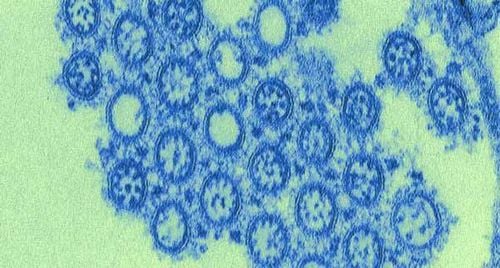This is an automatically translated article.
Influenza A virus, also known as bird flu, has infected many different animals, including ducks, chickens, pigs, whales, horses and seals. However, some influenza viruses are specific to certain species, with the exception of birds, which are hosts for all known influenza A viruses. So can bird flu spread to humans?
1. What is bird flu?
Bird flu is a viral infection that spreads from birds to other animals. Now, a particularly virulent strain of bird flu - H5N1 - continues to spread among poultry in Egypt and parts of Asia.
In fact, H5N1 is a highly pathogenic avian influenza (HPAI) virus. It causes most infected birds to die. And it can be fatal to humans and other mammals that contract the virus from birds. Since the first human case in 1997, H5N1 has caused nearly 60% of those infected to die.
But unlike the human flu virus, the H5N1 bird flu is not contagious from person to person. Very little human-to-human transmission occurs, with some transmission occurring through particularly close contact, such as a mother contracting the virus while caring for an ill infant.
2. Is bird flu contagious to humans?
Although influenza A virus does not usually infect humans, there have been some cases of infection with the virus. Human infection with avian influenza virus can occur when a certain amount of the virus enters the eyes, nose, or mouth, or is inhaled. This can happen when the virus is in the air (in droplets or possibly dust), a person breathes it in, or touches an object that has the virus on it and then touches their mouth, eyes, or nose. . The disease in humans can range from mild to severe.Influenza A virus has eight distinct gene segments. The segmented genome allows influenza A viruses from different species to mix and create new viruses if influenza A viruses from two different species infect the same person or the same animal. For example, if a pig is infected with human influenza A virus and influenza A virus at the same time, the new replicating viruses can mix existing genetic information (recombinant) and produce a new influenza A virus that can most genes from human viruses, hemagglutinin genes or neuraminidase genes and others from avian viruses. Then, the new virus can be capable of infecting people and spreading easily from person to person.
This is a major change in influenza A virus called antigenic shift. The antigenic shift results when a new influenza A virus emerges while most people have little or no infectious immune protection. If this new influenza A virus causes illness in humans and spreads easily from person to person, an influenza pandemic could occur.
Possible genetic recombination in a person co-infected with human influenza A and avian influenza viruses. The genetic information in these viruses can assemble to create a new influenza A virus with the hemagglutinin gene from the avian virus and other genes from the human virus. A hemagglutinin virus to which humans have little or no immunity has recombined with a human influenza virus that is more likely to result in human-to-human transmission and poses a major threat to public health. Therefore, careful evaluation of influenza A virus recovered from influenza A virus infected individuals is important to determine if recombination occurs.
People get bird flu from close contact with bird droppings. Some people get the H5N1 virus from cleaning or plucking infected birds. In China, there have been reports of infection through inhalation of aerosol materials in live bird markets. It is also possible that some people become infected after swimming or bathing in water contaminated with the feces of infected birds.
People do not get the virus from eating chicken or eggs when they are fully cooked.
There have been a few cases of a person getting the bird flu virus from another person - but only after close personal contact. To date, there has been no human-to-human transmission of the H5N1 virus.
Person-to-person spread of influenza A virus has been reported very rarely, and when present, it has been limited, ineffective and not maintained. However, because of the potential for influenza A viruses to be variable and capable of spreading easily between people, monitoring infection and human-to-human transmission is extremely important for health. community health.

Có một số trường hợp cúm A bị lây nhiễm sang người
3. Can bird flu spread from person to person?
As long as the bird flu virus doesn't turn into a human flu virus, it won't spread to people.
But in rare cases, after being in close contact with a person with avian flu, it is possible to infect others.
In Indonesia in 2006, bird flu spread to eight members of a family. Seven of them died. It is not clear exactly how this happened. Family members may have been exposed to infected birds.
4. Signs of avian influenza infection in humans
Symptoms of avian influenza infection in humans can vary. Symptoms may begin as signs of the common flu. This can make it more likely to get worse, rapidly progressing to a serious respiratory illness with a high risk of death.
In February 2005, researchers in Vietnam reported cases of avian influenza in humans, in which the virus infected the brain and gastrointestinal tract of two children. Both are dead. These cases clearly show that avian influenza in humans may not always be the same as cases of common flu.
Signs and symptoms reported due to avian influenza infection in humans have ranged from mild to severe and include conjunctivitis, flu-like illness (eg, fever, cough, sore throat, muscle aches) sometimes accompanied by nausea, abdominal pain, diarrhea, and vomiting, severe respiratory illness (eg, dyspnea, pneumonia, acute respiratory failure, viral pneumonia, respiratory failure), neurological changes (alternative change) mental status changes, seizures) and involvement of other organ systems. Virus strains H5N1, H7N9 have caused most of the human diseases worldwide to date, including the most severe diseases and mortality.
5. Diagnosis of avian influenza infection in humans
Human avian influenza virus infection cannot be diagnosed by clinical signs and symptoms alone; Laboratory testing is essential. Avian influenza virus infection is usually diagnosed by collecting a swab from the upper respiratory tract (nose or throat) of an infected person. (Testing is more accurate when swabs are collected within the first few days of infection.) This specimen is sent to a laboratory; laboratories for influenza A viruses using molecular testing, or by attempting to grow the virus, or both (Avian influenza A viruses should only be performed in laboratories with a biosafety level) high.)For critically ill patients, the collection and testing of lower respiratory tract samples can also be used to diagnose avian influenza virus infection. However, for some patients who are no longer seriously ill or have fully recovered, it can be difficult to detect influenza A virus in a specimen.
It is sometimes still possible to diagnose influenza A virus infection by looking for evidence of antibodies the body has made against the entry of this virus. This is not always possible as it requires two blood samples (one taken during the first week of illness and another taken about 3-4 weeks later). Also, it can take several weeks to verify the results and the test must be done in a special laboratory, such as at the US Centers for Disease Control and Prevention..
6. Treatment of avian influenza infection in humans
CDC currently recommends the use of a neuraminidase inhibitor for the treatment of avian influenza infections in humans. Analyzes of avian influenza viruses available worldwide show that most viruses are susceptible to oseltamivir, peramivir and zanamivir. These drugs must be given as soon as symptoms appear.
However, some evidence for antiviral resistance has emerged in the Asian H5N1 and H7N9 viruses, which have been isolated from several human cases. Monitoring viral resistance among influenza A viruses is important.
H5N1 in humans is a serious illness that requires hospitalization, isolation, and intensive care.

Bệnh nhân bị cúm như H5N1 thì cần được cách ly
7. Prevention of avian influenza infection in humans
The best way to prevent infection with avian influenza virus is to avoid sources of exposure. Most human infections with influenza A virus have occurred after direct contact with infected poultry.
People who have been in contact with infected birds can be vaccinated against influenza viruses. Although antiviral drugs are commonly used to treat the flu, they can also be used to prevent infection in people who have been exposed to the flu virus. When used to prevent seasonal flu, antivirals are 70% to 90% effective.
A seasonal flu shot will not prevent infection with influenza A virus, but may reduce the risk of co-infection with human and avian influenza A viruses. It is also possible to develop a vaccine that could protect people against avian influenza viruses. For example, the US government maintains a stockpile of vaccines to protect against certain H5N1 influenza viruses in Asia. A reserve vaccine could be used if similar H5N1 viruses begin to pass easily from person to person. Since flu viruses change, CDC continues to create new candidate viruses as needed.
Influenza A/H1N1 can be cured on its own if the patient has good resistance, and the disease is detected early and treated promptly.
Advantages of vaccination at Vinmec:
Children will be examined by pediatricians - vaccines, fully screened for physical and health problems, and advised on preventive vaccines. Diseases and injection regimen, how to monitor and care for children after vaccination before giving the indication for vaccination according to the latest recommendations of the Ministry of Health & World Health Organization to ensure the best effectiveness and safety. best for children. A team of experienced and professional pediatric doctors and nurses, understand children's psychology and apply effective pain relief methods for children during the vaccination process. 100% of vaccinated children were monitored for 30 minutes after vaccination and reassessed before leaving. Undertake medical supervision before, during and after vaccination at Vinmec Health System and always have an emergency team ready to coordinate with the vaccination department to handle cases of anaphylaxis, respiratory failure - circulatory arrest, ensuring Ensure timely and correct handling when incidents occur. The vaccination room is airy, with a play area, helping children feel comfortable as if they are walking and have a good mentality before and after vaccination. Vaccines are imported and stored in a modern cold storage system, with a cold chain that meets GSP standards, keeping vaccines in the best conditions to ensure quality. Parents will receive a reminder message before the vaccination date and their child's vaccination information will be synchronized with the National Immunization Information System. You can book an appointment directly at Vinmec Hospitals and Clinics nationwide according to the list HERE.
Articles refer to sources: Cdc.gov, Webmd.com
MORE:
Complications of seasonal flu How to treat influenza A/H1N1? Different types of flu: Influenza A, B, C and others













